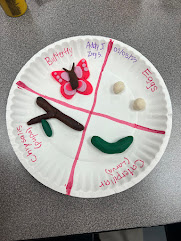Week 3 Blog - Elementary Science Methods (Addyson Junge)
Week 3 Blog - Elementary Science Methods (Addyson Junge)
February 6, 2025
Figure 1 Figure 2 Figure 3
- What did you learn this week?
- This week, I learned about the life cycles of insects, plants, and foods. In the lecture, I learned more about photosynthesis, cellular respiration, the carbon cycle, and modeling. After reviewing those materials, we jumped right into LS2: Ecology, which is the study of organisms within their environments. We talked about biotic factors, like fungi, bacteria, animals, etc., and also talked about abiotic factors, such as the air, soil, temperature, etc. Continuing with ecology, we learned the difference between environment and biome. An environment covers the land, animals, humans, and all the other factors, whereas biomes are large regions of the world.
- Are you able to relate what you learned to what you already knew?
- I already knew how a caterpillar grows to become an adult butterfly and the difference between butterflies and moths. I also knew that plants need sunlight, water (moisture), and soil to grow. When you give a seed these requirements, it will grow, just like ours did (Figure 3)! I can relate what I learned to what I knew in that aspect. Now, we planted another seed (Figure 1), providing the same requirements, and we will track the progress weekly. Switching gears to the carbon cycle, I remembered learning about it, but it was nice to get a refresher about how it works.
- How can you apply what you've learned to your teaching in the future?
- Something I can apply to my teaching in the future is doing project-based learning using models. They are a great way to focus on the details of the content. For example, when teaching students the life cycle, I would come up with ideas on how to use models to demonstrate that process. In this case, I loved the idea of using Play-Doh with a partner to build a butterfly (Figure 2) (or frog, bug, grass, flower, etc.). Another application I want to use from this class in my future classroom is the use of NGSS. The NGSS does a great job of setting clear performance expectations, and I believe it will better benefit students' ability to learn about science.





Hi Addy! I liked looking at the projects that you did in class this week! I also learned about life cycles along with photosynthesis and cellular respiration. I remembered learning about these when I was younger but had forgotten many key ideas so this was a great refresher! I liked what you said about applying project-based learning into your future teaching. I think that projects are so fun especially for children! It helps hold their engagement along with working with peers and retaining knowledge. I hope to also incorporate many projects into my future classroom!
ReplyDeleteHi Addy,
ReplyDeleteI like how you plan to apply this to your future teaching. I think that the use of modeling is a very great way to display information. I like how you worded it as "a great way to focus on the details of the content." I also agree that I learned more information about cellular respiration, the carbon cycle, and modeling.